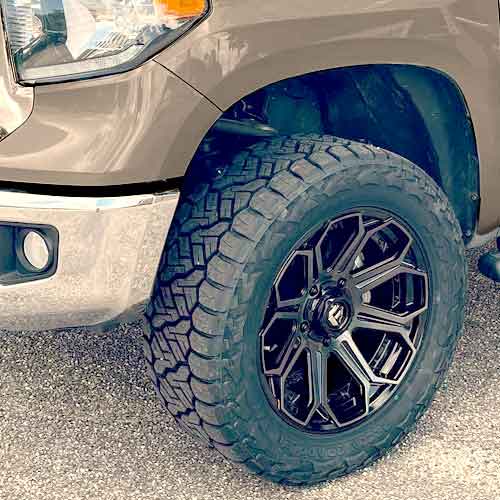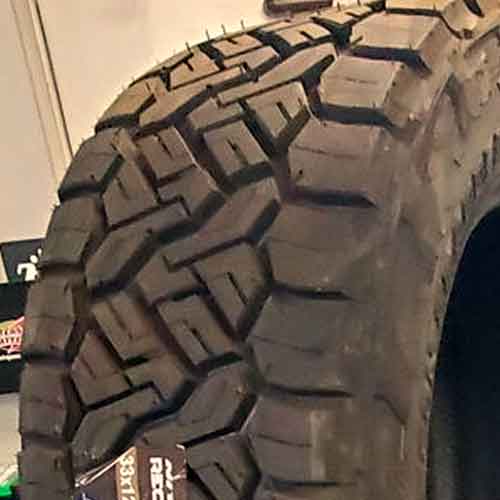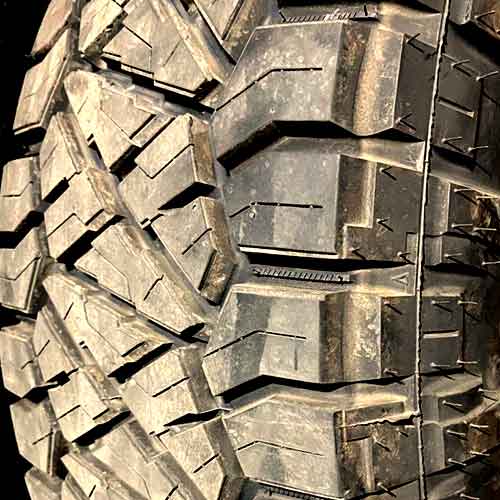The Nitto Recon Grappler is an all terrain tire, while the Nitto Ridge Grappler is a little aggressive for a hybrid, so it sits right in the middle of all terrain and mud terrain tires. So this tire is mostly considered as a hybrid, and lie in rugged terrain category.

Despite being an aggressive R/T, the Nitto Ridge Grappler is still able to provide decent lateral traction on dry roads, that’s because it’s shoulder lugs are quite similar to the Nitto Recon Grappler, but with middle section where Nitto Ridge although offers more biter but lacks in siping, the Recon Grappler offers better wet traction and snow performance. Besides that Recon Grappler also shows better fuel efficiency, noise, and resistance to tread wear comparatively, but off road, it can’t compete Nitto Ridge Grappler, especially on rocks.
Table of Contents
Tire Sizes
Let’s talk Nitto Recon Grappler first.
The tire comes in a total of 76 sizes (16 to 24 inches).
All sizes have speed ratings of either R or S, and load ratings are available in XL, XL, D, E, as well as F.
So this brings it’s weight up to 83 lbs for the largest size 37×13.50R24LT, and 40 lbs for the smallest, 265/50R20.
Moreover, all sizes have tread depth between 13 and 17/32″, where mostly sizes are available with 16/32″.
Coming to Nitto Ridge Grappler, the tire also offers 98 sizes (16 to 24 inches). Here the speed ratings are available in T and Q, whereas load ratings are similar to Recon Grappler.
Side Note: Only two sizes have T ratings, 265/75R16 116T and 265/70R16 116T XL).
All sizes get to have tread depth between 13 to 18/32″, where you are going to see most sizes with 16.4/32″.
Lastly the tire does not offer any warranty, whereas the Recon Grappler is the first one to provide 65k for non LT sizes and 55k for LTs.
A Side Note: I worked with these guys to make the following video:
Tread Appearance:
Let’s start things off with Nitto Recon Grappler first, from the middle.

Here the tire offers two triangular shaped ribs, which make 3 main zigzag channels.
(The two outer channels, and the lateral ones are interconnected with each other).
The two ribs in the middle also have voided spacing in between which further connect these lateral channels as well.
This way thread becomes very self cleaning.
The ribs in the middle seem to be made out of 4 blocks but they are joined together with strengthening foundations (these keep things stable on roads).
Moving towards the shoulders where less is going on here, as the tire makes small notches on sides, and very less siping.
The lugs are also not as thick, when compared to Nitto Ridge Grappler. Though both tires provide you with dual sidewall design for off road biting (especially when you pressure down the tires).
Moving on towards Nitto Ridge Grappler.

The tire makes similar lugs here on sides, but it forms wider gaps comparatively, these gaps also carry bold stone ejectors missing in the Recon Grappler.
The rest looks similar, well except for the sidewall lugs, which are thicker and more powerful in comparison.
These provide better traction on rocks, when you run the tire with lowered PSI.
The middle area of the tire is very aggressive, where it makes 4 ribs of triangular shapes facing each other.
All of them have sharp corners, and notches as well as full depth interlocking sipes.
And where the Recon Grappler gets strengthening foundations underneath its’ shoulder ribs, the Ridge Grappler offers that in the middle.
So even though it makes wider Z shaped grooves, on road the tire is still able to maintain its stability.
Talking about their inner construction, both tires have 3 ply polyester casing, so you get 3 ply sidewalls (which is pretty durable) and besides that you get 2 wide steel belts running on it, and 2 more layers, (cap plies) of nylon on very top.
On Road Performance:
All terrain tires have to limit their on road traction for off road performance. But in case of these two the compromise is very little, as both supply with a very well optimized tread which offers a decent rubber to road contact.
Dry Grip:
On dry roads, there are are a lot of factors that affect the directional grip of the tire, and here the tire’s weight, tread’s composition, rolling resistance, and the central tread area are considered the most.
Looking at all these factors, it makes sense why braking distances are smaller on Nitto Recon Grappler (a measurement of directional grip). This tire offers better rubber to road contact, and this then converts in to grip.
The Nitto Ridge Grappler, although offers foundation supports under it’s middle lugs, it’s wider tread voids don’t allow much rubber meet up, so grip get to be limited slightly.
Handling Stability:
Handling is considered with sidewalls and shoulders of the tire, and considering both, although the difference is very low, the bigger piece of the pie is again taken by Nitto Recon Grappler.
Even though both tires offer very minimal features on the tread and very similar siping, the Nitto Ridge Grappler lacks because of it’s larger lateral voids there.
Basically when the tire rolls on turns, the maximum emphasis of the weight is on the sides of the tire, that’s why Recon Grappler, as it makes more contact there, offers better stability.
But still there are two sizes (for Nitto Ridge), which offer better traction, 265/70R16 116T XL and 265/75R16 116T, as they have speed rating of up to T (greater).
Wet Performance:
The two most significant factors to consider on wet roads are traction, and hydroplaning. Let’s discuss them both one after another.
Wet Traction:
Both of these tires lack in siping severely, so they are both overall not so great when it comes to wet traction, still out of them, the Nitto Ridge Grappler offers surprisingly superior performance.
This has to do with it’s softer rubber composition, the Recon Grappler is stiffer and it’s shoulder siping is not as interlocking as it’s bigger brother.
The tire also lacks in hydroplaning (with a very small margin), which is also helps wet traction in-directly.
Hydroplaning:
Hydroplaning is when a tire can not grip on standing water, so here a tire needs to clear it off quickly, so it would not float.
But usually, hydroplaning is not an issue with highly voided treads, as these bald tires supply a lot of real estate for water to withdraw out rapidly.
That’s why with a more voided tire, Nitto Ridge Grappler offers better performance, and this is significant, as the faster the water channels out, the less there is left for sipes to work on.
Winter Performance
On snow, there are different terrains, but mostly on road snow is considered first, then comes deeper snow, then ice and others.
Now here, the Nitto Recon Grappler does great with slightly deeper and hard packed snow, though it still doesn’t qualify for 3 peak mountain snowflake rating.
Though this rating only tells you about the tire’s acceleration, that its alt least 10% better compared to standard touring all season tires.
The Nitto Ridge Grappler just has M+S, so it’s just better with deeper snow with it’s more voided tread.
Noise
Noise has to do with air flow (which hits the tread to produce noise).
Most of that air comes from shoulders, so this makes sense why Nitto Ridge Grappler is louder with it’s wider lateral gaps on sides.
The Recon Grappler on the other hand deals with noise in a better way, and although both tires offer variable pitch technology, Nitto Recon provides better pitch sequencing, and so very less groove resonance is generated.
Fuel Efficiency
Fuel usage is dependent on the rolling resistance, and with larger weight the Nitto Ridge Grappler puts more pressure on it’s tread so its harder to move.
Recon Grappler on the other side, is slightly easier to roll as it’s lighter in almost all sizes compared.
Tread Wear:
Tread wear and fuel efficiency are both linked by rolling resistance, so greater the fuel economy, the greater the tread life, and lower the rolling resistance.
That’s why Recon Grappler is better here too, and the tire comes with 55k miles warranty.
The Ridge Grappler with more weight and with its softer rubber, wears faster.
Off Road Performance
Off road performance is very critical, as there are a lot of variations, let’s settle this by talking about different terrains, which is the most important one.
Mud traction
If you are planing to go on muddy terrains with an AT tire, make sure you have a backup plan, as these tires don’t do so good there.
So it makes sense why Nitto Recon Grappler lacks slightly.
The Nitto Ridge Grappler offers X and Z shaped grooves which interlink with each other so mud get passed out of the tire quickly and effectively.
Sand Traction
On sand you need a lighter tire, so with lighter weight, the Recon Grappler does better on slopes.
You also need a tire with larger footprint, and here again the Recon Grappler offers more rubber to sand contact, it’s sidewall lugs are although slightly less thicker in comparison, the are optimized for sand.
Traction on Rocks
On rocks you need biters, a lot of it, you need powerful lugs, especially on sidewalls, and you need durability.
All these things are offered by Nitto Ridge Grappler, and the tire does it best. It’s triangular lugs in the middle offer powerful grip, it’s softer tread sticks on rocks, and it’s reinforced foundations keep them stable.
On sides the tire offers 3 ply sidewalls, and thick lugs on both sides (with dual design) and they provide great traction with lowered tire pressure.
The Nitto Recon Grappler also offers 3 ply construction and dual sidewalls, it’s sides are not as effective.
Similarly, the central lugs of the tire also offers good enough biters, but they aren’t still enough to outperform Nitto Ridge.
Summary
The Nitto Recon Grappler is an All-Terrain (A/T) tire, while the Nitto Ridge Grappler is a Rugged-Terrain (R/T) tire (a hybrid as some call it), so it’s not surprising to see this tire being better in overall off road performance, except for sand, that’s one area where Recon Grappler outperforms Ridge, due to it’s lighter weight.
Recon Grappler is although missing with 3pmsf rating, it still does better on snow, on on roads, it’s dry grip and stability is very noticeable.
Ridge Grappler lacks there a little bit, but it’s wet traction is still better in comparison, though it’s not so great in a broader picture.